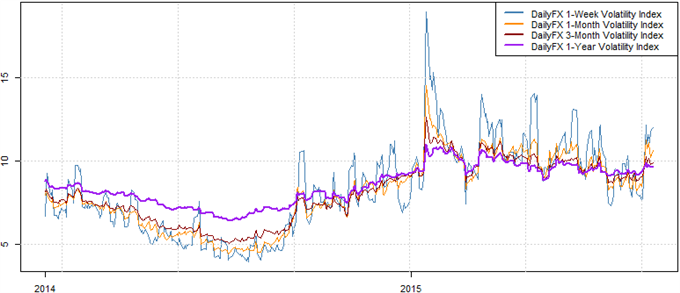- Forex volatility prices point to a big start to the month of September across FX markets
- Our focus remains on our high-volatility Breakout2 trading strategy
- We’ll keep a close eye on the DJ FXCM Dollar Index as it breaks key resistance
The US Dollar ends the month of August almost exactly where it began versus the Euro and other key counterparts. What might we expect in the coming week and in September?
All eyes turn to key economic event risk for the US economy in what promises to be a big week across financial markets. Indeed, forex volatility prices have surged following last week’s pronounced financial market turmoil and point to an important stretch for the US Dollar and other major currencies. The next question is obvious: which direction is more likely for the USD and broader counterparts?
As it stands, the Dow Jones FXCM Dollar Index has clawed back above key resistance and looks to resume its uptrend. Yet further gains are hardly guaranteed, and it will be very important to watch how it starts the new month of trading.
History suggests that currencies are more likely to set highs and lows at the beginning and the end of a given period—e.g. highs/lows for September are more likely to occur in the first week than mid-month. Past performance is not necessarily indicative of future results, but we’ll watch how the Dollar reacts to key data in what promises to be an exciting stretch across financial markets.
Derivatives markets are pricing in some fairly significant market moves in the coming week—further raising the likelihood of decisive price action.
Forex Volatility Prices Remain Elevated on Key Week for FX Markets

Data source: Bloomberg, DailyFX Calculations
Our data shows that the majority of FX traders tend to do poorly in times of elevated market volatility, and current market conditions warn that it may be another challenging week for traders. We have observed that majority of traders tend to range trade—buy when prices are low and sell when prices are high. This works well during quiet market conditions, but such a technique is also likely to do poorly during fast-moving markets.
Traders should likely avoid range trading until we see some semblance of ‘normalcy’ in currency trading markets. In the meantime we’ll look to our volatility-friendly Breakout2 to outperform across key US Dollar and Japanese Yen pairs.
Recommended Content
Editors’ Picks
EUR/USD regains traction, recovers above 1.0700

EUR/USD regained its traction and turned positive on the day above 1.0700 in the American session. The US Dollar struggles to preserve its strength after the data from the US showed that the economy grew at a softer pace than expected in Q1.
GBP/USD returns to 1.2500 area in volatile session

GBP/USD reversed its direction and recovered to 1.2500 after falling to the 1.2450 area earlier in the day. Although markets remain risk-averse, the US Dollar struggles to find demand following the disappointing GDP data.
Gold climbs above $2,340 following earlier drop

Gold fell below $2,320 in the early American session as US yields shot higher after the data showed a significant increase in the US GDP price deflator in Q1. With safe-haven flows dominating the markets, however, XAU/USD reversed its direction and rose above $2,340.
XRP extends its decline, crypto experts comment on Ripple stablecoin and benefits for XRP Ledger

Ripple extends decline to $0.52 on Thursday, wipes out weekly gains. Crypto expert asks Ripple CTO how the stablecoin will benefit the XRP Ledger and native token XRP.
After the US close, it’s the Tokyo CPI

After the US close, it’s the Tokyo CPI, a reliable indicator of the national number and then the BoJ policy announcement. Tokyo CPI ex food and energy in Japan was a rise to 2.90% in March from 2.50%.